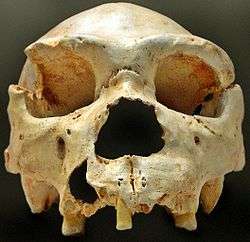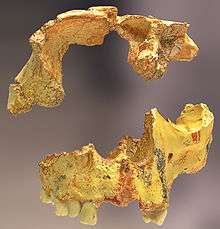Atapuerca Mountains
| Atapuerca Mountains | |
|---|---|
| (Spanish: Sierra de Atapuerca) | |
 | |
| Highest point | |
| Prominence | 1,085 m (3,560 ft) |
| Coordinates | 42°22′00″N 3°31′20″W / 42.36667°N 3.52222°WCoordinates: 42°22′00″N 3°31′20″W / 42.36667°N 3.52222°W |
| Geography | |
 | |
| Archaeological Site of Atapuerca | |
|---|---|
| Name as inscribed on the World Heritage List | |
 | |
| Type | Cultural |
| Criteria | iii, v |
| Reference | 989 |
| UNESCO region | Europe and North America |
| Inscription history | |
| Inscription | 2000 (24th Session) |
The Atapuerca Mountains (Sierra de Atapuerca in Spanish) is an ancient karstic region of Spain, in the province of Burgos, Castile and Leon and near Atapuerca and Ibeas de Juarros. It contains several caves, where fossils and stone tools of the earliest known hominins in Western Europe have been found, belonging to the species Homo antecessor (or Homo erectus antecessor) and Homo heidelbergensis. These hominid remains, representing the earliest known in western Europe, have been dated as being up to 1.2 million and 600 thousand years old, respectively. These caves, known collectively as the "Archeological Site of Atapuerca", are a UNESCO World Heritage Site.
Geography of the Atapuerca Mountains


The Bureba Pass connects the Ebro river valley leading to the Mediterranean Sea and the Duero valley leading to that river's outlet at the Atlantic Ocean. This conjunction results in an ecotone rich in species derived from both ecosystems. The pass was part of a Roman causeway, the pilgrimage Way of Saint James and is now traversed by the N-I and AP-1 highways. The location of the Archeological Site of Atapuerca between two major watersheds and being an important mountain pass may explain the intensity and continuity of hominid habitation found there.[1]
Archaeological Site of Atapuerca
The sites in this area were found during the construction of railway cuts through Gran Dolina, Galería and Elefante, and in the cave of Sima de los Huesos. The scientific excavation, started by Francisco Jordá Cerdá in 1964, has found human remains from a wide range of ages: early humans to the Bronze Age and modern man. Sites in the area have also yielded stone artifacts. It was excavated by a team led by Emiliano Aguirre from 1978 until 1990, and then jointly by Eudald Carbonell, José María Bermúdez de Castro and Juan Luis Arsuaga.
The regional government of Castile and León has designated the site an Espacio cultural. The Zona Arqueológica sierra de Atapuerca is protected under Spanish law as a Bien de Interés Cultural.
Because of its importance, in 2000, the "Archaeological Site of Atapuerca" was added to the UNESCO list of World Heritage Sites.
Portalón (1910-)
In the 20th century, several archaeologists including Jesús Carballo (1910–1911), Geoffrey Clark (1971), José María Apellániz (1973–1983) and the team led by Juan Luis Arsuaga (2000-) recovered ceramic remains from the late Neolithic, Age of Bronze and Lower Roman Empire.
Galería de la Eduarda y el Kolora (1972)
Discovered in 1972 by a local speleology group, there are intact rock paintings in this cave.
Galería (1978-)
A fragment of jaw was recovered in the 1970s, and a fragment of skull in 1995, both belonging to Homo heidelbergensis, dating to 600,000 to 400,000 years ago. There are many remains of animals, including a lion, as well as plants and tools dating from about 400,000 years ago.
Trinchera Mar Ferrer i Nuria Passarell (1981-)

The site of Gran Dolina is a huge cave with several levels (TD-11 to TD-1), whose excavation began in September 1981:
- TD-11: Mousterian tools have been found.
- Level TD-10 could have been a camp of Homo heidelbergensis, with tools and bison remains.
- Level TD-8, reached by the first time in 1994, has provided magnificent carnivores.
- In level TD-7, a leg of a bovid (like a mouflon) in anatomical position was recovered in 1994.
- TD-6 (Aurora stratum): In 1994 and 1995, archaeologists found over 80 bone fragments from five or six hominids dating to between 850,000 and 780,000 years ago. About 25% of the human remains found here showed the first evidence of cannibalism. These finds are at least 250,000 years older than any other hominid yet discovered in western Europe. It is still debated which species these fossils belong to, either Homo erectus, Homo heidelbergensis or a newly discovered species called Homo antecessor. Some paleoanthropologists who have studied the findings at Gran Dolina argue that Homo antecessor may have given rise to Homo heidelbergensis, who eventually gave rise to Neandertals. The erectus-like fossils were also found with retouched flake and core stone tools.
- Level TD-5 could have been a den of carnivores.
- In TD-4 (dated to 780,000 BCE), during the 1991 excavation, four lithic pieces were found. Also, it retains a dozen remnants of Ursus dolinensis, a new species of bear.
- At the lower levels (TD-1 and TD-2), there are no fossils.
Sima de los Huesos (1983-)

The most famous site in Atapuerca is the Sima de los Huesos (the pit of bones). This site is located at the bottom of a 13-metre (43-foot) deep "chimney" reached by scrambling through the cave system of the Cueva Mayor.[2]

Beginning in 1997, the excavation team has located more than 5,500 human bones dated to an age of at least 350,000 years old, corresponding to the Middle Pleistocene and representing around 28 skeletons of the species Homo heidelbergensis,[3] together with remains of Ursus deningeri and a biface called Excalibur. It is hypothesized that this Acheulean axe made of red quartzite was some kind of ritual offering for a funeral. Ninety percent of the known Homo heidelbergensis remains have been obtained from this site. The fossil pit bones include:

- A complete cranium (Skull 5), nicknamed Miguelón, and fragments of other craniums, as Skull 4, nicknamed Agamenón and skull 6, nicknamed Rui (from El Cid, a local hero).
- A complete pelvis (Pelvis 1), nicknamed Elvis, in remembrance of Elvis Presley.
- Mandibles, teeth, a lot of postcranial bones (femora, hand and foot bones, vertebrae, ribs, etc.)
- Remains of a child with craniosynostosis were found and dated to 530,000 BP. The find was considered to provide evidence for food sharing in early humans.[4]
- Mitochondrial DNA (mtDNA) from a 400,000-year-old femur has been sequenced, the oldest hominin mtDNA recovered as of 2013. The mtDNA was found to be closer to the mtDNA from Denisova hominins than to the mtDNA from Neanderthals.[5]
- In 2016 nuclear DNA analysis determined the Sima hominins are Neanderthals and not Denisova hominins and the divergence between Neanderthals and Denisovans predates 430,000 years ago.[6][7]
The excavators suggest that the concentration of bones in the pit may represent the practice of burial by the inhabitants of the cave. A competing theory cites the lack of small bones in the assemblage and suggests that the remains were washed into the pit by natural agencies.

Sima del Elefante (1996-)
According to José María Bermúdez de Castro, co-director of research at an archaeological site in Atapuerca, findings have uncovered "anatomical evidence of the hominids that fabricated tools more than one million years ago", which may have been the earliest West European hominid. First they discovered a tooth [8] in June 2007 and then, in 2008, a fragment of jawbone,[9] and a proximal phalanx.

Cueva del Mirador (1999-)
This site provides information on farmers and ranchers from the Neolithic and Age of Bronze.
Orchids Valley (2000-2001) and Hundidero (2004–2005)
Stone tools from the Upper Paleolithic have been obtained from these areas.
Hotel California (2006)
An open-air settlement.
History
Atapuerca is the location of the battle of Atapuerca (1054) between the troops of Ferdinand I of Castile and his brother García V of Navarre.
See also
- List of fossil sites (with link directory)
- Orce, Sima de las Palomas, Sidrón Cave, Forbes' Quarry, Devil's Tower (Gibraltar), and other important archeological sites in the Iberian Peninsula where prehistoric human remains have been found.
- Pierolapithecus
References
- ↑ Arsuaga, Juan Luis (2009-04-01). The Neanderthal's Necklace: In Search of the First Thinkers. Basic Books. p. 145. ISBN 0786740736.
- ↑ http://www.msn.com/en-us/news/technology/prehistoric-skull-with-puncture-wounds-could-be-worlds-first-murder-mystery/ar-BBkjj9A
- ↑ Greenspan, Stanley (2006-02-07). How Symbols, Language, and Intelligence Evolved from Early Primates to Modern Human. ISBN 0-306-81449-8.
- ↑ Gracia A, Arsuaga JL, Martínez I, Lorenzo C, Carretero JM, Bermúdez de Castro JM, Carbonell E. (2009). "Craniosynostosis in the Middle Pleistocene human Cranium 14 from the Sima de los Huesos, Atapuerca, Spain", Proc Natl Acad Sci U S A. 2106(16):6573-8. PMID 19332773
- ↑ Callaway, Ewen. "Hominin DNA baffles experts". Nature.com. Retrieved 8 December 2013.
- ↑ magazine, Ewen Callaway,Nature. "Oldest Ancient-Human DNA Details Dawn of Neandertals". Scientific American. Retrieved 2016-03-14.
- ↑ Meyer, Matthias; Arsuaga, Juan-Luis; de Filippo, Cesare; Nagel, Sarah; Aximu-Petri, Ayinuer; Nickel, Birgit; Martínez, Ignacio; Gracia, Ana; de Castro, José María Bermúdez (2016-03-14). "Nuclear DNA sequences from the Middle Pleistocene Sima de los Huesos hominins". Nature. advance online publication. doi:10.1038/nature17405. ISSN 1476-4687.
- ↑ "'First west Europe tooth' found". BBC News. 2007-06-30.
- ↑ "'Fossil find is oldest European yet'". Nature News. 2008-03-26.
External links
| Wikimedia Commons has media related to Atapuerca. |
- Official Web Page of the Atapuerca UCM-ISCIII Research Group
- American Museum of Natural History-Atapuerca
- www.atapuerca.com